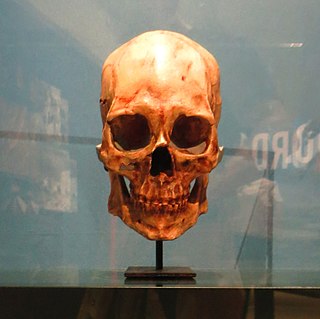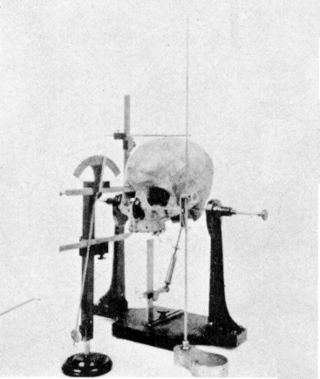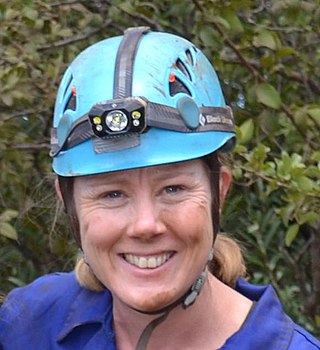Related Research Articles

Biological anthropology, also known as physical anthropology, is a scientific discipline concerned with the biological and behavioral aspects of human beings, their extinct hominin ancestors, and related non-human primates, particularly from an evolutionary perspective. This subfield of anthropology systematically studies human beings from a biological perspective.
Race is a categorization of humans based on shared physical or social qualities into groups generally viewed as distinct within a given society. The term came into common usage during the 16th century, when it was used to refer to groups of various kinds, including those characterized by close kinship relations. By the 17th century, the term began to refer to physical (phenotypical) traits, and then later to national affiliations. Modern science regards race as a social construct, an identity which is assigned based on rules made by society. While partly based on physical similarities within groups, race does not have an inherent physical or biological meaning. The concept of race is foundational to racism, the belief that humans can be divided based on the superiority of one race over another.

Kennewick Man or Ancient One was a Paleo-Indian whose skeletal remains were found washed out on a bank of the Columbia River in Kennewick, Washington, on July 28, 1996. Radiocarbon tests show the man lived about 8,900 to 9,000 years before present, making his skeleton one of the most complete ever found this old in the Americas, and thus of high scientific interest for understanding the peopling of the Americas.

Anthropometry refers to the measurement of the human individual. An early tool of physical anthropology, it has been used for identification, for the purposes of understanding human physical variation, in paleoanthropology and in various attempts to correlate physical with racial and psychological traits. Anthropometry involves the systematic measurement of the physical properties of the human body, primarily dimensional descriptors of body size and shape. Since commonly used methods and approaches in analysing living standards were not helpful enough, the anthropometric history became very useful for historians in answering questions that interested them.

Forensic anthropology is the application of the anatomical science of anthropology and its various subfields, including forensic archaeology and forensic taphonomy, in a legal setting. A forensic anthropologist can assist in the identification of deceased individuals whose remains are decomposed, burned, mutilated or otherwise unrecognizable, as might happen in a plane crash. Forensic anthropologists are also instrumental in the investigation and documentation of genocide and mass graves. Along with forensic pathologists, forensic dentists, and homicide investigators, forensic anthropologists commonly testify in court as expert witnesses. Using physical markers present on a skeleton, a forensic anthropologist can potentially determine a person's age, sex, stature, and race. In addition to identifying physical characteristics of the individual, forensic anthropologists can use skeletal abnormalities to potentially determine cause of death, past trauma such as broken bones or medical procedures, as well as diseases such as bone cancer.
Osteology is the scientific study of bones, practised by osteologists. A subdiscipline of anatomy, anthropology, and paleontology, osteology is the detailed study of the structure of bones, skeletal elements, teeth, microbone morphology, function, disease, pathology, the process of ossification, and the resistance and hardness of bones (biophysics).

Craniometry is measurement of the cranium, usually the human cranium. It is a subset of cephalometry, measurement of the head, which in humans is a subset of anthropometry, measurement of the human body. It is distinct from phrenology, the pseudoscience that tried to link personality and character to head shape, and physiognomy, which tried the same for facial features. However, these fields have all claimed the ability to predict traits or intelligence.
The Robert J. Terry Anatomical Skeletal Collection is a collection of some 1,728 human skeletons held by the Department of Anthropology of the National Museum of Natural History of the Smithsonian Institution, Washington, D.C., United States. The skeletons have been widely used in research for anthropology and forensic science.

Forensic facial reconstruction is the process of recreating the face of an individual from their skeletal remains through an amalgamation of artistry, anthropology, osteology, and anatomy. It is easily the most subjective—as well as one of the most controversial—techniques in the field of forensic anthropology. Despite this controversy, facial reconstruction has proved successful frequently enough that research and methodological developments continue to be advanced.
William White Howells was a professor of anthropology at Harvard University.

Mexican settlement in the Philippines comprises a multilingual Filipino ethnic group composed of Philippine citizens with Mexican ancestry. The immigration of Mexicans to the Philippines dates back to the Spanish period.

Cephalometry is the study and measurement of the head, usually the human head, especially by medical imaging such as radiography. Craniometry, the measurement of the cranium (skull), is a large subset of cephalometry. Cephalometry also has a history in phrenology, which is the study of personality and character as well as physiognomy, which is the study of facial features. Cephalometry as applied in a comparative anatomy context informs biological anthropology. In clinical contexts such as dentistry and oral and maxillofacial surgery, cephalometric analysis helps in treatment and research; cephalometric landmarks guide surgeons in planning and operating.

Skeletonization is the state of a dead organism after undergoing decomposition. Skeletonization refers to the final stage of decomposition, during which the last vestiges of the soft tissues of a corpse or carcass have decayed or dried to the point that the skeleton is exposed. By the end of the skeletonization process, all soft tissue will have been eliminated, leaving only disarticulated bones.
Richard L. Jantz is an American anthropologist. He served as the director of the University of Tennessee Anthropological Research Facility from 1998–2011 and he is the current Professor Emeritus of the Department of Anthropology at the University of Tennessee, Knoxville. His research focuses primarily on forensic anthropology, skeletal biology, dermatoglyphics, anthropometry, anthropological genetics, and human variation, as well as developing computerized databases in these areas which aid in anthropological research. The author of over a hundred journal articles and other publications, his research has helped lead and shape the field of physical and forensic anthropology for many years.
The history of anthropometry includes its use as an early tool of anthropology, use for identification, use for the purposes of understanding human physical variation in paleoanthropology and in various attempts to correlate physical with racial and psychological traits. At various points in history, certain anthropometrics have been cited by advocates of discrimination and eugenics often as part of novel social movements or based upon pseudoscience.

The study of geometric morphometrics in anthropology has made a major impact on the field of morphometrics by aiding in some of the technological and methodological advancements. Geometric morphometrics is an approach that studies shape using Cartesian landmark and semilandmark coordinates that are capable of capturing morphologically distinct shape variables. The landmarks can be analyzed using various statistical techniques separate from size, position, and orientation so that the only variables being observed are based on morphology. Geometric morphometrics is used to observe variation in numerous formats, especially those pertaining to evolutionary and biological processes, which can be used to help explore the answers to a lot of questions in physical anthropology. Geometric morphometrics is part of a larger subfield in anthropology, which has more recently been named virtual anthropology. Virtual anthropology looks at virtual morphology, the use of virtual copies of specimens to perform various quantitative analyses on shape and form...

CranID was created in 1992 by anthropologist Richard Wright of the University of Sydney to infer the probable geographic origin of unknown crania that are found in archaeological, forensic and repatriation cases. Wright created the program to establish uniformity in cranial morphology based on the assumption that there is a high correlation between geographical location and cranial morphology. This was the first standardized program to evaluate the similarity and dissimilarity of cranial morphological characteristics of an unknown cranium and the database.
Osteoware is a free data recording software for human skeletal material that is managed through the Smithsonian Museum of Natural History. It is used by biological anthropologists to document data relevant to research and forensic applications of human skeletal remains in a standardized and consistent way. It has influenced other skeletal recording software, and has been successfully used at the Smithsonian for collecting data relevant to biological anthropology. Osteoware is the only free, individual-use software for the collection of data on skeletal material in anthropology.

Marina Elliott is a Canadian biological anthropologist, who is known for being one of the six Underground Astronauts of the Rising Star Expedition.
Mortuary archaeology is the study of human remains in their archaeological context. This is a known sub-field of bioarchaeology, which is a field that focuses on gathering important information based on the skeleton of an individual. Bioarchaeology stems from the practice of human osteology which is the anatomical study of skeletal remains. Mortuary archaeology, as well as the overarching field it resides in, aims to generate an understanding of disease, migration, health, nutrition, gender, status, and kinship among past populations. Ultimately, these topics help to produce a picture of the daily lives of past individuals. Mortuary archaeologists draw upon the humanities, as well as social and hard sciences to have a full understanding of the individual.
References
- ↑ "Dennis Dirkmaat publishes new book on forensic anthropology". Computer Weekly News. 31 May 2012. Archived from the original on 29 March 2015. Retrieved 27 November 2014.
- ↑ Armelagos, George J. (2003). "A Century of Skeletal Biology and Paleopathology: Contrasts, Contradictions, and Conflicts". American Anthropologist. 105 (1): 53–64. doi:10.1525/aa.2003.105.1.53.
- ↑ Ousley, Stephen; Jantz, Richard (2014). "Ch. 15: Fordisc 3 and Statistical Methods for Estimating Sex and Ancestry". In Dirkmaat, Dennis (ed.). A Companion to Forensic Anthropology. John Wiley & Sons. pp. 311–329.
- ↑ Ousley, S.D., and R.L. Jantz (2005) FORDISC 3.0: Personal Computer Forensic Discriminant Functions. University of Tennessee
- ↑ Kelly, John (14 September 2006). "Couple Fleshes Out Skeletons' Past". Washington Post. Archived from the original on 29 March 2015. Retrieved 27 November 2014.
- ↑ Howells, WW. (1995). Who's Who in Skulls. Ethnic Identification of Crania from Measurements. Cambridge, Mass.: Peabody Museum.: Papers of the Peabody Museum of Archaeology and Ethnology. pp. vol. 82, pp. 108.
- 1 2 Ousley, Stephen, and Jantz, Richard. "Fordisc Help File, Version 1.35." Mercyhurst Archaeological Institute. http://math.mercyhurst.edu/~sousley/Fordisc/Help/Fordisc3_Help.pdf
- ↑ Elliott, Marina; Collard, Mark (2009-11-11). "Fordisc and the determination of ancestry from cranial measurements". Biology Letters. The Royal Society. 2009 (5): 849–852. doi:10.1098/rsbl.2009.0462. PMC 2827999 . PMID 19586965.
- ↑ "Poster: Elliott and Collard 2012 Going head to head: FORDISC vs CRANID in the determination of ancestry from craniometric data". meeting.physanth.org. Retrieved 2015-10-22.
- ↑ "Poster: Elliott and Collard 2012 Going head to head: FORDISC vs CRANID in the determination of ancestry from craniometric data". meeting.physanth.org. Retrieved 2015-10-22.
- ↑ "UT Knoxville | Forensic Anthropology Center | Forensic Anthropology Data Bank Archived 2015-10-29 at the Wayback Machine ". fac.utk.edu. Retrieved 2015-11-15.